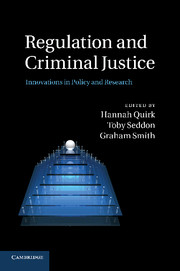Book contents
- Frontmatter
- Contents
- List of figures and tables
- Notes on contributors
- Foreword
- Acknowledgements
- 1 Regulation and criminal justice: exploring the connections and disconnections
- PART I Regulation and criminal justice: framing the debate
- PART II Criminal justice as regulation: responsivity, alternatives and expansion
- 5 Nodal governance and the Zwelethemba Model
- 6 Regulatory compliance: organizational capacities and regulatory strategies for environmental protection
- 7 An intoxicated politics of regulation
- 8 Governing by civil order: towards new frameworks of support, coercion and sanction?
- 9 Counter-terrorism and community relations: anticipatory risk, regulation and justice
- PART III Regulation of criminal justice: monitoring, effectiveness and accountability
- Index
- References
7 - An intoxicated politics of regulation
Published online by Cambridge University Press: 04 February 2011
- Frontmatter
- Contents
- List of figures and tables
- Notes on contributors
- Foreword
- Acknowledgements
- 1 Regulation and criminal justice: exploring the connections and disconnections
- PART I Regulation and criminal justice: framing the debate
- PART II Criminal justice as regulation: responsivity, alternatives and expansion
- 5 Nodal governance and the Zwelethemba Model
- 6 Regulatory compliance: organizational capacities and regulatory strategies for environmental protection
- 7 An intoxicated politics of regulation
- 8 Governing by civil order: towards new frameworks of support, coercion and sanction?
- 9 Counter-terrorism and community relations: anticipatory risk, regulation and justice
- PART III Regulation of criminal justice: monitoring, effectiveness and accountability
- Index
- References
Summary
Introduction
The preceding chapter by Lynch-Wood and Williamson presents a case for something that has become known as ‘responsive’ regulation. On one hand, their chapter rehearses a series of well-worn arguments that connect to an established hegemony of thought around regulation. On the other hand, the chapter represents an attempt to explore how ‘responsive’ regulatory strategies might be modified to take account of Small and Medium Enterprises (SMEs). In doing so, the authors raise some key and under-explored issues, particularly in relation to how the law-abiding tendencies of firms are mediated by size. In so far as those arguments appear on the face of things to offer a corrective to business-lobby driven appeals for regulatory withdrawal from SMEs, this is an interesting contribution. Moreover, the size of a firm has a crucially important bearing upon the visibility of its offending and the ability of regulators to respond, and therefore the authors open up some important territory here. This chapter argues that however well intentioned their analysis is in terms of its attempt to place SMEs under greater scrutiny, at best it ends up presenting a naive and oversimplified understanding of the regulatory process, and at worst, is likely to provide support to the intensification of regulatory disengagement that has characterized UK government policy in recent years.
- Type
- Chapter
- Information
- Regulation and Criminal JusticeInnovations in Policy and Research, pp. 162 - 191Publisher: Cambridge University PressPrint publication year: 2010
References
- 4
- Cited by



